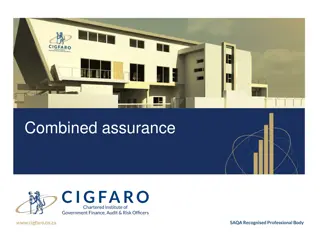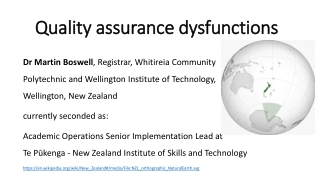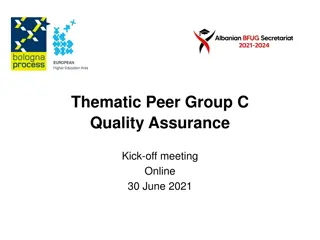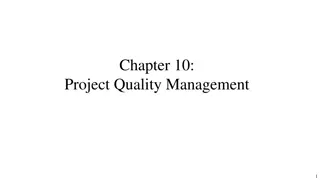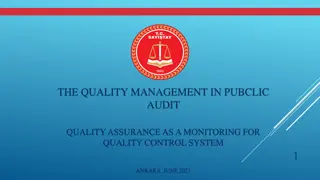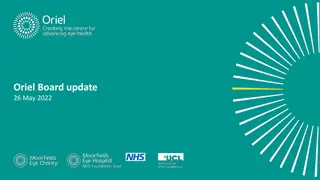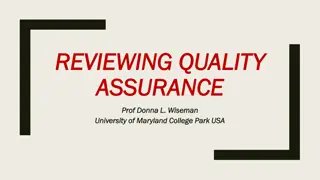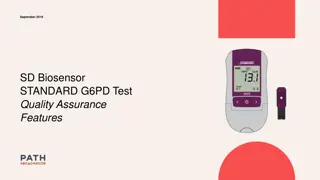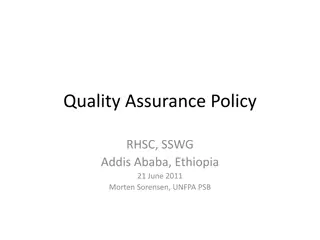Understanding Quality Assurance in Hospitals
Quality assurance in hospitals is a vital system aimed at managing resources and ensuring quality controls in healthcare. It involves evaluating and improving processes to enhance healthcare delivery. Learn about the importance of quality assurance, its impact on patient care, and strategies for implementation. Explore the dimensions of quality as per the Joint Commission on Accreditation of Healthcare Organizations (JCAHO) to ensure excellence in healthcare services.
Download Presentation

Please find below an Image/Link to download the presentation.
The content on the website is provided AS IS for your information and personal use only. It may not be sold, licensed, or shared on other websites without obtaining consent from the author. Download presentation by click this link. If you encounter any issues during the download, it is possible that the publisher has removed the file from their server.
E N D
Presentation Transcript
QUALITY ASSURANCE IN HOSPITALS By: Dr. Digvijay Sharma Director School of Health Sciences, CSJM University
INTRODUCTION The system of quality assurance is developed for up taking the management of resources and reassurance of quality controls in the field of hospital requirements. It is a necessary part of the system to critically check and assure the quality of the products, services, management strategies and various other resources for their healthy and appropriate functioning. Quality assurance is a procedure which helps identify the need for improvement in sectors involved and also helps to gather information about the present working current scenario. Quality assurance has been a major concern in the field of improvement and inspections referred to healthcare delivery systems in India and worldwide. 1. Wolff AM. A review of methods used for medical quality assurance in hospitals: advantages and disadvantages. Journal of Quality in Clinical Practice. 1994 Jun 1;14(2):85-97. Graham NO. QUALITY ASSURANCE IN HOSPITALS-STRATEGIES FOR ASSESSMENT AND IMPLEMENTATION. The Journal for Healthcare Quality (JHQ). 1982 Apr 1;4(2):14. 2.
WHAT IS QUALITY ? It is the process of meeting one s expectations Quality is something which refers to doing accurate things at appropriate time settings. It is the process of gathering information about the functioning of an equipment or service. QUALITY It is a function of perception of an individual regarding a service
WHY IS QUALITY IMPORTANT ? Helps in development of lacking healthcare facilities like diagnostic or treatment protocols Helps combat market competition and reduces discrepancy in services Helps in advancing healthcare strategies It transforms the services from administration centric to patient centric relieving more and more patients Recruitment of highly qualified and specialized medical staff and administrative staff Improvisations can be made in communication technology Increased awareness among patients and normal individuals about the working and excellent services rendered at the hospital increasing the market value Development of good quality systematic way of planning and management of healthcare services in hospitals Good quality provides better system and advantageous level of satisfaction among care takers as well as care givers. 1. 2. Wolff AM. A review of methods used for medical quality assurance in hospitals: advantages and disadvantages. Journal of Quality in Clinical Practice. 1994 Jun 1;14(2):85-97. Graham NO. QUALITY ASSURANCE IN HOSPITALS-STRATEGIES FOR ASSESSMENT AND IMPLEMENTATION. The Journal for Healthcare Quality (JHQ). 1982 Apr 1;4(2):14.
DIMENSIONS OF QUALITY According to the Joint commission on Accreditation of Health care organizations (JCAHO), there are few criterions which are considered as the most important dimensions of quality described below: Safety of patients Effectiveness of treatment regimes Efficiency of equipment and methods used Timeliness of the treatment regime Efficacy of the team of professionals involved Respect and caring Continually available services and resources Appropriateness of the various regimes rendered within a hospital based setting. 1. 2. Wolff AM. A review of methods used for medical quality assurance in hospitals: advantages and disadvantages. Journal of Quality in Clinical Practice. 1994 Jun 1;14(2):85-97. Graham NO. QUALITY ASSURANCE IN HOSPITALS-STRATEGIES FOR ASSESSMENT AND IMPLEMENTATION. The Journal for Healthcare Quality (JHQ). 1982 Apr 1;4(2):14.
ADVANTAGES OF QUALITY Reduction in wasting of resources Reduction in time for various strategies Good equation between professionals Woking in the hospital Management of patients and doctors in harmony Satisfaction of patients achieved at lesser cost Improvisation in system and confidence towards the healthcare system Lower work rejections and lesser complaints regarding services 1. 2. Wolff AM. A review of methods used for medical quality assurance in hospitals: advantages and disadvantages. Journal of Quality in Clinical Practice. 1994 Jun 1;14(2):85-97. Graham NO. QUALITY ASSURANCE IN HOSPITALS-STRATEGIES FOR ASSESSMENT AND IMPLEMENTATION. The Journal for Healthcare Quality (JHQ). 1982 Apr 1;4(2):14.
REQUIREMENTS FOR QUALITY Customer participation Management of processes within hospitals Systematic collection of observations for quality review Quality criteria and management criteria should be predefined and planned 1. 2. Wolff AM. A review of methods used for medical quality assurance in hospitals: advantages and disadvantages. Journal of Quality in Clinical Practice. 1994 Jun 1;14(2):85-97. Graham NO. QUALITY ASSURANCE IN HOSPITALS-STRATEGIES FOR ASSESSMENT AND IMPLEMENTATION. The Journal for Healthcare Quality (JHQ). 1982 Apr 1;4(2):14.
COMPONENTS OF QUALITY SYSTEM INPUT: Adequate space, necessary tools and equipment, necessary medications, administration of departments of surgery, OT, ICU, technicians, physicians, pharmacy, etc. 1 PROCESS: Clinical decision making, admission, care of patients, discharge planning, follow up of patients 2 OUTPUT: Results at the end of care, physiological parameters, functional status, quality, efficacy, efficiency, etc. 3 OUTCOME: End of the result yields outcomes which is in the form of patient satisfaction, cost of treatment and feedback given by the patients. 4 1. 2. Wolff AM. A review of methods used for medical quality assurance in hospitals: advantages and disadvantages. Journal of Quality in Clinical Practice. 1994 Jun 1;14(2):85-97. Graham NO. QUALITY ASSURANCE IN HOSPITALS-STRATEGIES FOR ASSESSMENT AND IMPLEMENTATION. The Journal for Healthcare Quality (JHQ). 1982 Apr 1;4(2):14.
STAGES OF QUALITY SYSTEM Stage 1: Achieving certifications from the government offices, declaration of quality assurance, management of responsibilities given by the government bodies. Stage 2: Internal documentation which undergoes a process of evaluation and replanning stages, preparation of quality management and quality control procedures. Stage 3: Apply general quality procedures, distribution of quality assurance programs or schemes Stage 4: Preparation of plans and specific quality control methods Stage 5: Application and training of individuals concerned for maintenance and control of quality. Stage 6: Audit is an essential part of quality control as it is the procedural part of examining the quality of the system working in healthcare.
QUALITY MANAGEMENT It is the overall management of products or services used in healthcare systems. In hospital based settings, management of all the services is termed as quality management. It basically deals with the process and independent factors which constitute the efficient and effective performance output. It gives an experience of present working scenarios and development of strategies for irregular or faulty practises. 1. 2. Wardhani V, Utarini A, van Dijk JP, Post D, Groothoff JW. Determinants of quality management systems implementation in hospitals. Health policy. 2009 Mar 1;89(3):239-51.. Farzadnia E, Hosseini Z, Riahi A. Study of hospital quality management and improvement rates in the hospitals. Journal of Humanities Insights. 2017 Mar 1;1(01):7-11.
ELEMENTS OF QUALITY MANAGEMENT Discussion of error generally made by the hospitals Education and training of the staff members Formation of an appropriate quality management team Development of quality policy and quality manual Development of Standard Operating Procedures Constant monitoring, Supervision and feedback Medical audit system and rectification of errors 1. 2. Wardhani V, Utarini A, van Dijk JP, Post D, Groothoff JW. Determinants of quality management systems implementation in hospitals. Health policy. 2009 Mar 1;89(3):239-51.. Farzadnia E, Hosseini Z, Riahi A. Study of hospital quality management and improvement rates in the hospitals. Journal of Humanities Insights. 2017 Mar 1;1(01):7-11.
DOCUMENTATION QUALITY MANUAL The documentation system includes 4 tiers of Quality management system which are: 1 tier Manual tier 2 tier Procedural tier Consists of objectives, policies formed, philosophies defined. 3 tier job Instruction tier Consists of purpose, scope and standard procedures being opted for management. 4 tier Forms and Records Includes worksheets and instructions laid for working of any system. Includes the forms filled after quality check of instruments and systems for record purposes. 1. 2. Wardhani V, Utarini A, van Dijk JP, Post D, Groothoff JW. Determinants of quality management systems implementation in hospitals. Health policy. 2009 Mar 1;89(3):239-51.. Farzadnia E, Hosseini Z, Riahi A. Study of hospital quality management and improvement rates in the hospitals. Journal of Humanities Insights. 2017 Mar 1;1(01):7-11.
QUALITY CONTROL Defines a procedure which involves routine evaluation and estimation of working and independency of the system working as a healthcare system. Includes evaluation of planned or systemic actions Quality control also refers to the set of activities formulated to find out whether the instruments or services being provided by a healthcare hospital is up to the standards or not. On the basis of these quality checks control of the quality of system depends. The quality of any system or instrument or treatment regime is pre-defined, and thus controlling the quality of such a thing is determined as an important part of the healthcare system. 1. 2. Wardhani V, Utarini A, van Dijk JP, Post D, Groothoff JW. Determinants of quality management systems implementation in hospitals. Health policy. 2009 Mar 1;89(3):239-51.. Farzadnia E, Hosseini Z, Riahi A. Study of hospital quality management and improvement rates in the hospitals. Journal of Humanities Insights. 2017 Mar 1;1(01):7-11.
QUALITY ASSURANCE It is a planned system of monitoring procedures of process conducted by personnel not directly involved in the inventory compilation/development process. This is done by adopting a standard set of process and usual QA techniques like review, training, facilitation etc. It can be termed as defect prevention. QA activities ensure that the process is defined and appropriate. Methodology and standards development are examples of QA activities. Quality assurance is an audit function. It is activity oriented. 1. 2. Wardhani V, Utarini A, van Dijk JP, Post D, Groothoff JW. Determinants of quality management systems implementation in hospitals. Health policy. 2009 Mar 1;89(3):239-51.. Farzadnia E, Hosseini Z, Riahi A. Study of hospital quality management and improvement rates in the hospitals. Journal of Humanities Insights. 2017 Mar 1;1(01):7-11.
QUALITY IMPROVEMENT Maintaining the process of quality standards through out and efforts made to improve upon is termed as continuous quality improvement. There are four quality improvement initiatives that hospitals could use as a yardstick to achieve the best outcomes:- Nurses must be actively involved throughout the process, Quality outcomes should be transparent, Decisions must be supported by quality research, Staff should feel empowered to make decisions and be held accountable 1. 2. Wardhani V, Utarini A, van Dijk JP, Post D, Groothoff JW. Determinants of quality management systems implementation in hospitals. Health policy. 2009 Mar 1;89(3):239-51.. Farzadnia E, Hosseini Z, Riahi A. Study of hospital quality management and improvement rates in the hospitals. Journal of Humanities Insights. 2017 Mar 1;1(01):7-11.
COMPONENTS OF QUALITY IMPROVEMENT SERVICE IMPROVEMENT Introduction of latest technology, ensure supplies, maintenance and standardization, implementation of standard operating procedure Suitable modern techniques, following of certification guidelines, certification from NABH, fix accountability, detection of problems and their solutions PROCESS IMPROVEMENT Regular staff training programs, develop staff work culture, introduce quality circle discussions, inculcate team spirit, leadership, motivation and enthusiasm among staff members. PEOPLE S IMPROVEMENT 1. 2. Wardhani V, Utarini A, van Dijk JP, Post D, Groothoff JW. Determinants of quality management systems implementation in hospitals. Health policy. 2009 Mar 1;89(3):239-51.. Farzadnia E, Hosseini Z, Riahi A. Study of hospital quality management and improvement rates in the hospitals. Journal of Humanities Insights. 2017 Mar 1;1(01):7-11.
TOTAL QUALITY MANAGEMENT Take the entire organization, patient, staff and its activities into consideration. Quantum output to meet pre- determined standard/ objective. Manage step by step i.e. Planning, Organizing, Controlling, Provisioning, Staffing. Determination f overall goals and priorities and application of education training programs among workers. Implementation of standardized procedures and elimination of minute problems. 1. 2. 3. Al-Shdaifat EA. Implementation of total quality management in hospitals. Journal of Taibah University Medical Sciences. 2015 Dec 1;10(4):461-6.. Mosadeghrad AM. Essentials of total quality management: a meta-analysis. International journal of health care quality assurance. 2014 Jul 8.. Vituri DW, vora YD. Total Quality Management and hospital nursing: an integrative literature review. Revista Brasileira de Enfermagem. 2015 Sep;68:945-52.
ASPECTS OF TQM The four P s of the total quality management include: PEOPLE S PROCESS Commitment improvement PATIENT S Needs PRODUCT Satisfaction in time 1. 2. 3. Al-Shdaifat EA. Implementation of total quality management in hospitals. Journal of Taibah University Medical Sciences. 2015 Dec 1;10(4):461-6.. Mosadeghrad AM. Essentials of total quality management: a meta-analysis. International journal of health care quality assurance. 2014 Jul 8.. Vituri DW, vora YD. Total Quality Management and hospital nursing: an integrative literature review. Revista Brasileira de Enfermagem. 2015 Sep;68:945-52.
PRINCIPLES OF TQM Commitment towards projects Organization and structure Normal financial control activities Supplier relationship Training, education and safety measures Customer relationships Communications networking Teamwork encouragement Certification level like ISO Measurement of functions Natural use of tools, techniques and skills 1. 2. 3. Al-Shdaifat EA. Implementation of total quality management in hospitals. Journal of Taibah University Medical Sciences. 2015 Dec 1;10(4):461-6.. Mosadeghrad AM. Essentials of total quality management: a meta-analysis. International journal of health care quality assurance. 2014 Jul 8.. Vituri DW, vora YD. Total Quality Management and hospital nursing: an integrative literature review. Revista Brasileira de Enfermagem. 2015 Sep;68:945-52.
QUALITY DIAMOND Quality diamond standards are referred to those which constitute the four elements of the quality services like : customer satisfaction continuity of excellent services commitment in improvement of staff quality expectations of patients and staff 1. 2. 3. Al-Shdaifat EA. Implementation of total quality management in hospitals. Journal of Taibah University Medical Sciences. 2015 Dec 1;10(4):461-6.. Mosadeghrad AM. Essentials of total quality management: a meta-analysis. International journal of health care quality assurance. 2014 Jul 8.. Vituri DW, vora YD. Total Quality Management and hospital nursing: an integrative literature review. Revista Brasileira de Enfermagem. 2015 Sep;68:945-52.
References 1. Wolff AM. A review of methods used for medical quality assurance in hospitals: advantages and disadvantages. Journal of Quality in Clinical Practice. 1994 Jun 1;14(2):85-97. 2. Graham NO. QUALITY ASSURANCE IN HOSPITALS-STRATEGIES FOR ASSESSMENT AND IMPLEMENTATION. The Journal for Healthcare Quality (JHQ). 1982 Apr 1;4(2):14. 3. Wardhani V, Utarini A, van Dijk JP, Post D, Groothoff JW. Determinants of quality management systems implementation in hospitals. Health policy. 2009 Mar 1;89(3):239-51.. 4. Farzadnia E, Hosseini Z, Riahi A. Study of hospital quality management and improvement rates in the hospitals. Journal of Humanities Insights. 2017 Mar 1;1(01):7-11 5. Al-Shdaifat EA. Implementation of total quality management in hospitals. Journal of Taibah University Medical Sciences. 2015 Dec 1;10(4):461-6.. 6. Mosadeghrad AM. Essentials of total quality management: a meta-analysis. International journal of health care quality assurance. 2014 Jul 8.. 7. Vituri DW, vora YD. Total Quality Management and hospital nursing: an integrative literature review. Revista Brasileira de Enfermagem. 2015 Sep;68:945-52.


